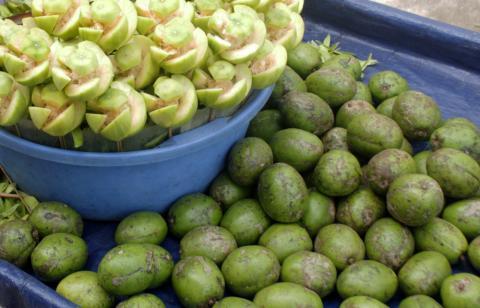
Tapereba is a member of the family Anacardiaceae or Sumac family of the genus Spondias L. or mombin, containing the species Spondias mombin L. or yellow mombin. The tree is native to tropical America and grows throughout the tropical regions of the world. It is a tropical plant that does well in warm climates and does not tolerate frost. It is also known by the nomenclatures Yellow Mombin and Spondias mombin.
The entire plant is used medicinally—the roots, bark, leaves, and fruit are made into infusions, teas, and extracts. The fruit is rich in nutrients and is a versatile ingredient in many recipes. The tree is also used in a variety of ways: the wood is soft and easy to work, finishing smoothly, and it is also used as paper pulp. The bark is made into dugout canoes and the stems have many utilizations as in posts, boxes, matches, general carpentry, tool handles, millwork, utility plywood, and furniture components.
What does tapereba (hog plum) look like?
Tapereba is a deciduous tree that loses its leaves after the growing season and reaches a height of approximately eighty-two feet in height at maturity and a diameter of about twenty-four inches. It has a thick bark and grows compound leaves made up of five to nine pairs of leaflets. The blooms are produced on terminal stalks resulting in small, yellow fruit with a leathery texture. Tapereba flesh is a thin layer and surrounds a single seed. The flowers are fragrant and cream-colored, producing fruit that grow in clusters and are tasty with juicy pulp and with a white pit in the center. Some other names for the fruit are caja, mopi, Spanish plum, and jobo, depending on the region.
Health Benefits of Tapereba (Hog Plum)
Tapereba is rich in vitamins and minerals that include vitamins A and C it is also a good source of calcium, magnesium, and iron. It has a low fat content and the carotenoids present in the vitamin A are not affected by heat because it is fat soluble. Vitamin A promotes ocular health, aids in bone growth, and increases the immune system as a catalyst in the development of white blood cells. Tapereba is rich in vitamin C and contains a high level of antioxidants, protecting the body from free radicals. It is also a factor in the body’s absorption of iron and helps the body to develop collagen production, a factor in the healing process. To get the best results from vitamin C the fruit should be eaten fresh. The calcium present in tapereba is essential in bone health, muscle function, and dental health. Its iron content regulates the distribution of the oxygen in the blood to the cells.
How To Grow Tapereba
The tapereba tree is a tropical plant that does well in warm, moist, climates and is susceptible to frost. It should be planted in full sunlight in fertile, well-draining soil. It is a fast growing tree, attaining a height of approximately ten feet in two years when planted from seed, and will produce fruit in about five years. The tree, like most tropical plants, does well when neglected and can be grown as a container plant in colder climates. It can be planted in deep containers from eighteen to thirty inches in diameter and it is important to transplant it to accommodate the root system. It is used as a decorative plant on a patio or deck and on the property. When planting outdoors, start it from seed or seedling in semi-shaded areas then gradually move to more sunlight to avoid leaf burn.
Eating Tapereba
Tapereba is a versatile food that is used in many recipes. It is usually eaten fresh as a snack or an ingredient in salads. Unripe fruit lends itself to pickling recipes. Tapereba can be juiced, made into jams and jellies, and used as an ingredient in ice cream. Tapereba shoots can be eaten fresh or added to salads and can be cooked in soups and stews. The roots store water and can be tapped if water is not available. The fruit is a healthy choice for pregnant women as it is low in calories and nutritional, and reduces the incidence of morning sickness.








